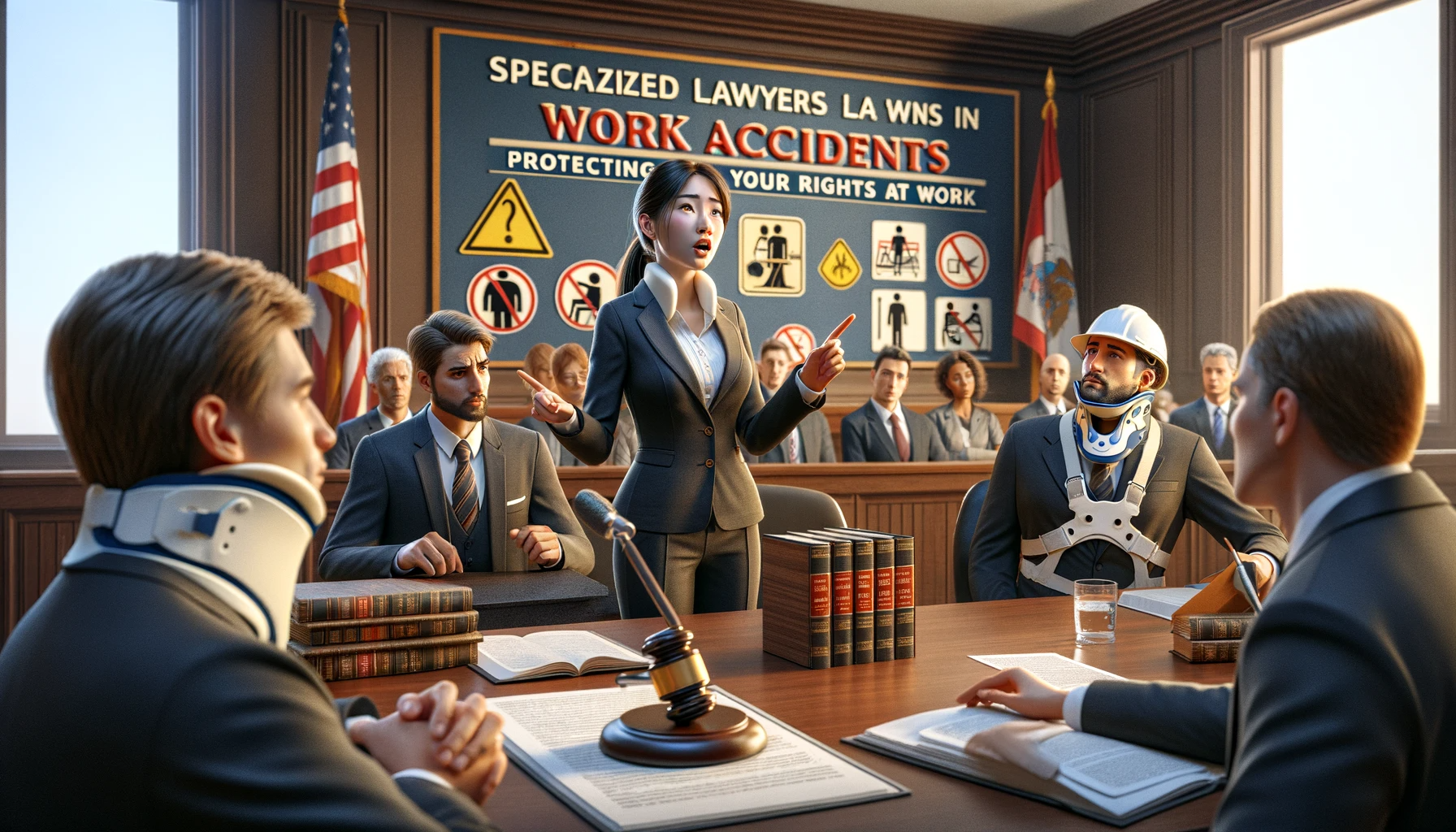Understanding Work Accident Charges
Work accident charges are calculated based on various parameters, and understanding this can be complex. In 2023, the rules governing these charges have seen modifications and updates. Below, we delve into several key factors that influence work accident charges.
The Nature and Severity of the Injury
One primary factor that influences work accident charges is the nature and severity of the injury incurred. Typically, more severe injuries attract higher charges because they require more extensive medical treatment. Such injuries may also result in longer periods off work, hence higher compensation for lost wages. These factors contribute to an increase in the overall charge relating to the work incident.
The Employee's Occupational Role
The work role of the employee involved in the accident often has a bearing on the costs associated with the work accident. Some roles involve higher risks than others, making insurance policy premiums for such roles more expensive. Consequently, if an accident occurs, the charges could be significantly higher than for a less risky role.
Another significant determinant of work accident charges is the coverage of the
Workers' compensation insurance. Different insurance plans offer varied coverage levels, which directly impacts the overall charge of a work accident. The broader and more comprehensive the coverage, the higher the corresponding charges will likely be.
The Cost of Rehabilitation and Ongoing Care
In some instances, work accidents may result in the need for prolonged medical care or rehabilitation services. The cost of these services can sometimes exceed the initial treatment costs, leading to increased overall work accident charges. This cost is often influenced by the duration and intensity of care required, and the year 2023 has seen an increase in healthcare costs.
Legal Costs Involved
If the work accident leads to legal proceedings, this can result in additional costs. Fees for legal representation, court costs, and any potential settlements or judgments can significantly increase the total charges related to a work accident. The nature of these charges often depends on the specifics of the case and its outcomes.
Factors Influencing the Cost of Work Accidents

The Severity of the Injury
The more severe an injury, the higher costs can be expected. Emergency care, hospitalization, surgeries, medications, and physiotherapy sessions can all significantly contribute to the total expenses incurred. Severe injuries may also require ongoing, long-term care which is another factor to consider.
The Type of Occupation
Some jobs pose more risks than others. For instance, construction, mining, and other physically demanding industries often see higher accidents rates due to the inherent danger of the work. Consequently, work accidents in these sectors tend to be more expensive due to their severe nature. Thus, the type of occupation plays a significant role in influencing the cost of work accidents.
Worker's compensation is a mandated insurance that provides compensation to employees who suffer job-related injuries. The cost can vary greatly depending on the nature of the business, the number of employees, and the level of risk associated with the industry. Higher premiums may be levied against companies with a history of accidents or in high-risk sectors.
The Repercussions of Lost Productivity
When an employee is absent due to a work-related
Injury, it not only impacts them but also the productivity of the organization. This loss of productivity can result in delays, missed deadlines, additional overtime costs for other employees, or even lost business. These indirect costs can often exceed the direct costs of the injury.
Legal and Regulatory Costs
Legal costs can also significantly affect the overall price tag of a workplace accident. If an employee files a lawsuit against the company due to unsafe working conditions, the company could face substantial legal fees. Additionally, regulatory fines and penalties from safety agencies for violations of workplace safety standards can also add to the overall cost.
Average Costs of Work Accidents in 2023
Introduction to Accident Costs
In 2023, the financial implications of workplace accidents continue to be a major concern for businesses. These costs can vary widely depending on severity, location, and the industry in which the business operates.
Occurrences and Expenses of Minor Accidents
On one end of the spectrum, minor accidents can result in relatively low costs. For example, incidents that result in minimal injuries such as minor sprains or cuts may involve medical expenses ranging from $500 to $2,000. Additionally, there may be expenses related to
Workers' compensation, productivity loss, and administrative paperwork ranging from about $1,000 to $5,000.
Implications of Moderate Accidents
Moderate workplace accidents, like fractures or
Burns, are more costly and can result in substantial expenses in the range of $10,000 to $50,000. This includes not only direct medical costs but also the potential productivity losses and rehabilitation services. Depending on state laws and company policies, there could also be increased costs related to workers' compensation premiums following these incidents.
Severe Workplace Accidents and Their Costs
At the extreme end, severe workplace accidents such as those involving serious injuries or fatalities can lead to costs upwards of $1 million. This estimate takes into account immediate medical costs, long-term care, potential legal fees, and significant increases to a company's workers' compensation premiums. It's also important to include indirect costs such as the potential impact on company reputation and morale.
Factors Influencing Work Accident Costs
Various factors play a role in determining the costs of a work-related accident. These can include the severity of the accident, the injured worker's age and health status, the industry in which the accident occurred, and location-specific factors such as local healthcare costs and
Workers' compensation laws. Companies are recommended to invest in proactive safety measures to prevent such incidents as this can result in significant cost savings in the long run.
Legal Aspects of Work Accident Charges
Labor Laws and Workplace Accidents
The legal aspects concerning work accidents are primarily governed by labor laws. In many jurisdictions, employers are obligated to ensure a safe working environment for their employees. When injuries occur within the workplace, several labor laws such as the Occupational Health and Safety Act (OHSA) may come into play. These laws mandate that employers address any potential hazards and implement necessary precautions to prevent workplace injuries. Failure to comply with these regulations could result in significant penalties and charges.
Another considerable aspect of work accident charges involves workers' compensation insurance. This insurance system is designed to cover the costs of medical treatments, rehabilitation, and lost wages for employees who get injured on the job. However, employers’ costs can significantly increase due to increased premiums, particularly if the workplace is deemed unsafe or if there is a high incidence of accidents. If an employer is found liable for the accident due to negligence or failure to comply with safety standards, they may also face additional legal charges and penalties.
Beyond workers' compensation claims,
Personal injury lawsuits are another significant legal aspect tied to work accident charges. When injured at work, employees may have the right to seek compensation beyond what is covered by worker’s compensation, especially when the employer's negligence contributed to the accident. Employers can face heavy financial damages resulting from such lawsuits, further exacerbating the total charges related to workplace accidents.
Regulatory Fines and Penalties
In cases where employers fail to meet the required safety standards or violate labor laws, regulatory bodies can impose fines and penalties. These vary widely, depending on the severity and frequency of the violations. Some regulatory authorities can also prosecute severe cases, leading to even more extensive legal repercussions and charges.
Settlement Costs and Legal Fees
Often overlooked, settlement costs and legal fees also contribute to work accident charges. In the event of disputes over workers’ compensation claims or
Personal injury lawsuits, employers might need to hire legal representation. The costs of legal advice, court proceedings, dispute resolution, and potential settlement payments can significantly increase the total expenses linked to a work accident in 2023.
Insurance Coverage and Work Accident Costs
Understanding the Role of Insurance in Work Accidents
Insurance plays a pivotal role in the financial dynamics of work accidents. Typically, employers are required to have
Workers’ compensation insurance which provides coverage for medical costs, rehabilitation expenses, and wage replacement for employees who get injured or become ill due to work-related activities. In 2023, the cost of workers' compensation insurance varies based on several factors such as the employer's industry, payroll, claim history, and the state where they operate.
Out-of-Pocket Costs and Deductibles
While insurance coverage goes a long way in managing work accident expenses, there can still be significant out-of-pocket costs. These may include deductibles that the policy stipulates must be met before insurance coverage takes effect. Additionally, certain expenses might not be fully covered by insurance, leaving the company liable for the difference. Companies need to be aware of these potential expenses in order to prepare effectively for such scenarios.
Increased Premiums Following Accidents
It's essential to note that the occurrence of a work accident can cause a surge in insurance premiums, especially if the accident leads to large claims. The calculation of these premiums is based on the previous claims history and the current risk assessment of the workplace. Therefore, investing in workplace safety measures can help deter accidents, keep insurance premiums manageable, and reduce overall costs.
The Impact of Legal Fees and Settlements
In the event of severe accidents, companies may face additional costs in the form of legal fees and settlements. If an employee decides to sue the company for damages, these costs can quickly escalate. While workers' compensation insurance typically covers legal fees, there could be limits on these coverages.
Indirect Costs of Workplace Accidents
Finally, while direct costs such as medical expenses, rehabilitation, and compensation are more straightforward, workplace accidents can also lead to significant indirect costs. These include productivity loss, training replacement workers, investigating the accident, implementing corrective measures, and repairing damaged property. Insurance does not typically cover these costs, which can further increase the financial burden on the company.
Minimizing the Financial Impact of Work Accidents
Work accidents can implicate significant financial implications for businesses. However, steps can be taken to minimize these costs. A few strategies to reduce the financial impact of workplace accidents include implementing safety training, investing in protection gear, purchasing insurance, and fostering a proactive safety culture.

Promoting Safety Training
One of the primary preventative measures against work accidents is safety training. Providing employees with comprehensive and recurrent safety training courses helps them understand the risks involved in their jobs and the necessary precautions to avoid potential accidents. This investment pays off in the long run by reducing the number of accidents and thereby decreasing financial liability.
Investing in Protective Gear
Another critical aspect in minimizing the financial impact of work accidents is the provision of appropriate personal protective equipment (PPE). Ensuring that workers have access to and are utilizing necessary safety gear reduces the risk of severe injuries. Consequently, this leads to lower medical expenses and fewer compensation claims.
Securing Workplace Insurance
Getting the right insurance coverage is fundamental to safeguarding a business from heavy financial losses following workplace accidents. Various types of insurance, such as
Workers' compensation insurance, can cover medical costs, rehabilitation expenses, and wage replacement for injured employees, limiting the direct financial impact on the company.
Fostering a Proactive Safety Culture
Creating a proactive safety culture within the organization is another effective way to curtail the financial consequences of work accidents. It involves promoting open communication about safety issues, encouraging all staff members to participate actively in safety enhancement, and recognizing their contributions towards building a safer work environment. A proactive safety culture can help anticipate and prevent possible accidents, mitigating their financial impact.
Forecasting Future Trends in Work Accident Charges
Understanding the Current Pricing Model
The first step to forecasting future trends in work accident charges is understanding how they're currently calculated. In 2023, costs are typically determined based on factors such as the severity of the
Injury, the type and duration of medical treatment required, and the impact on the worker's ability to continue performing their job. The employer’s insurance plans also play a significant role in settling the final costs.
Impact of Technological Advancements
As we move forward, technological advancements are expected to significantly influence future trends in work accident charges. Use of artificial intelligence and machine learning in healthcare can potentially lower the cost of diagnosing and treating work-related injuries. Likewise, advancements in safety technology might reduce the frequency and severity of workplace accidents, thus impacting the overall costs related to them.
Changing Workforce Demographics
Changing demographics of the workforce are another vital trend to consider. As the population ages and more people postpone retirement, we could see an increase in the types of injuries that are more common among older workers. Alternatively, the influx of younger workers, who may be less experienced, could lead to an increase in certain types of workplace accidents. Both scenarios could influence future charges.
Effect of Regulatory Changes
Regulatory changes often have a direct impact on work accident charges. Changes to health and safety regulations,
Workers' compensation laws, and insurance requirements could all potentially affect future costs. For example, if new laws are implemented requiring higher safety standards or enhanced worker protections, this could result in increased costs for businesses but might reduce actual accident-related charges due to decreased occurrence rates.
Economic Factors
Lastly, general economic conditions also influence work accident charges. In periods of economic growth, companies may invest more in safety measures, potentially reducing the number of accidents. Conversely, in times of economic downturn, cost-cutting measures could lead to higher accident rates and subsequently higher charges. The relationship between economic factors and work accident charges is complex and multifaceted, which should be taken into account when forecasting future trends.
Conclusion
The cost of a work accident in 2023 can vary significantly based on several factors. One of the primary determinants is the severity of the
Injury, with more severe injuries often resulting in higher costs due to the need for extensive medical treatment and potentially long-term rehabilitation. Additionally, the state's workers' compensation laws play a crucial role in determining the financial implications of a work accident. These laws dictate the extent of coverage provided to injured workers, including medical expenses, lost wages, and vocational rehabilitation.
Furthermore, the specific circumstances of the accident can also impact the overall cost. For example, accidents involving multiple workers or those resulting from safety violations may lead to higher costs due to potential legal penalties and increased insurance premiums.
Given these factors, it is crucial for employers to prioritize workplace safety to prevent accidents and mitigate their financial and human costs. Implementing comprehensive safety measures, providing adequate training to employees, and maintaining a safe work environment are essential steps in reducing the risk of work-related injuries. By prioritizing safety, employers can not only protect their workers but also minimize the financial burden associated with workplace accidents.
Look for an attorney who has the right legal resources for your legal needs.
Contact us here on the
Warmuth Law website or through our hotline 888-517-9888.
Frequently Asked Questions (FAQ's)
1. What factors determine the cost of a work accident in 2023?
The cost of a work accident can be influenced by factors such as the severity of the injury, medical expenses, lost wages, and potential legal fees.
2. Does workers' compensation cover all costs associated with a work accident?
Workers' compensation typically covers medical expenses and a portion of lost wages, but the exact coverage can vary based on state laws and the specific circumstances of the accident.
3. Are employers liable for all costs associated with a work accident?
Employers are generally responsible for providing
Workers' compensation insurance, which covers most costs associated with work-related injuries. However, there may be exceptions depending on the circumstances of the accident.
4. Can an injured worker sue their employer for a work accident in 2023?
In most cases,
Workers' compensation laws prevent employees from suing their employers for work-related injuries. However, there may be exceptions for cases involving gross negligence or intentional harm.
5. How can employers reduce the cost of work accidents in 2023?
Employers can reduce the cost of work accidents by implementing comprehensive safety programs, providing proper training to employees, and promptly addressing any workplace hazards.













